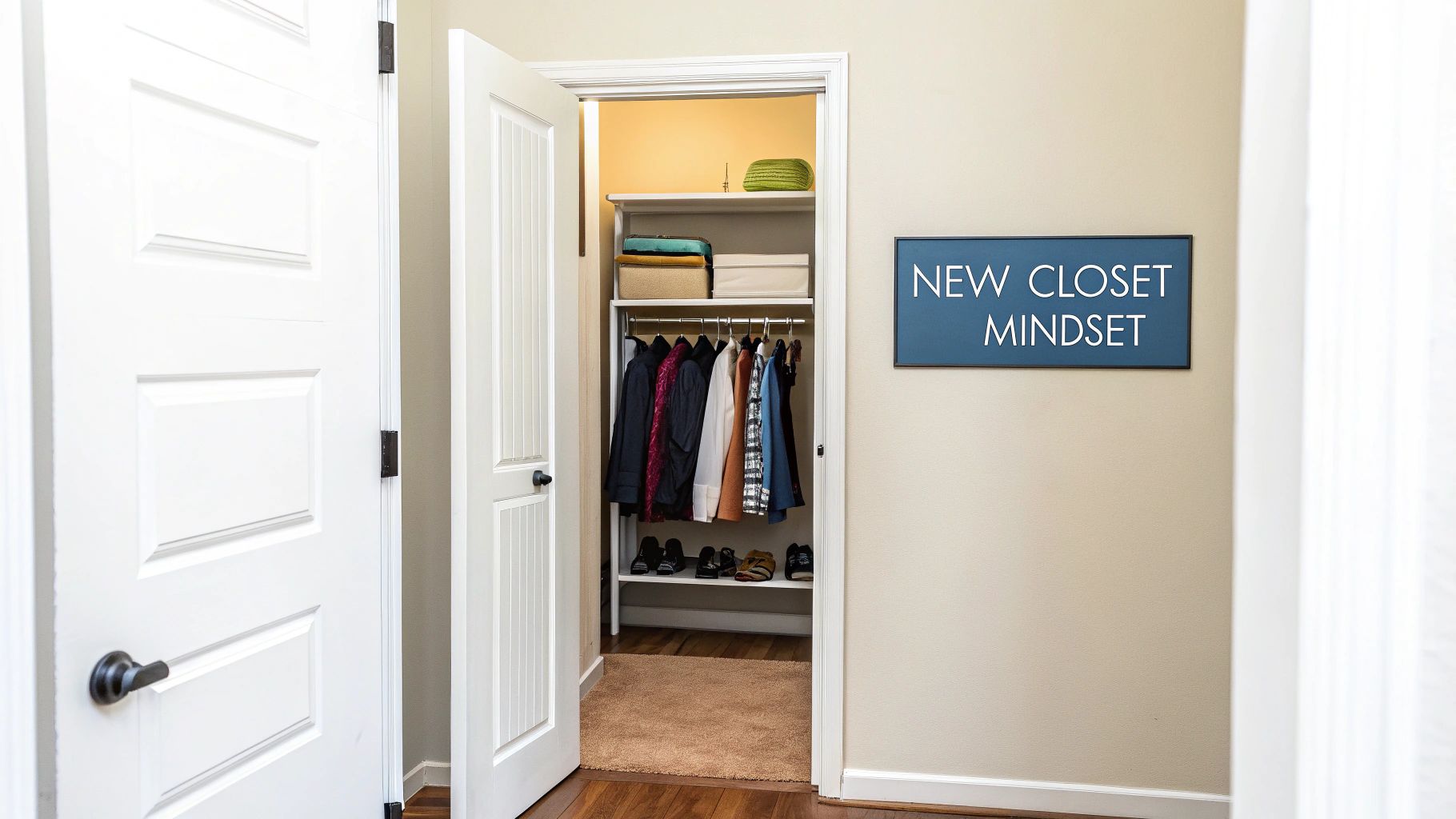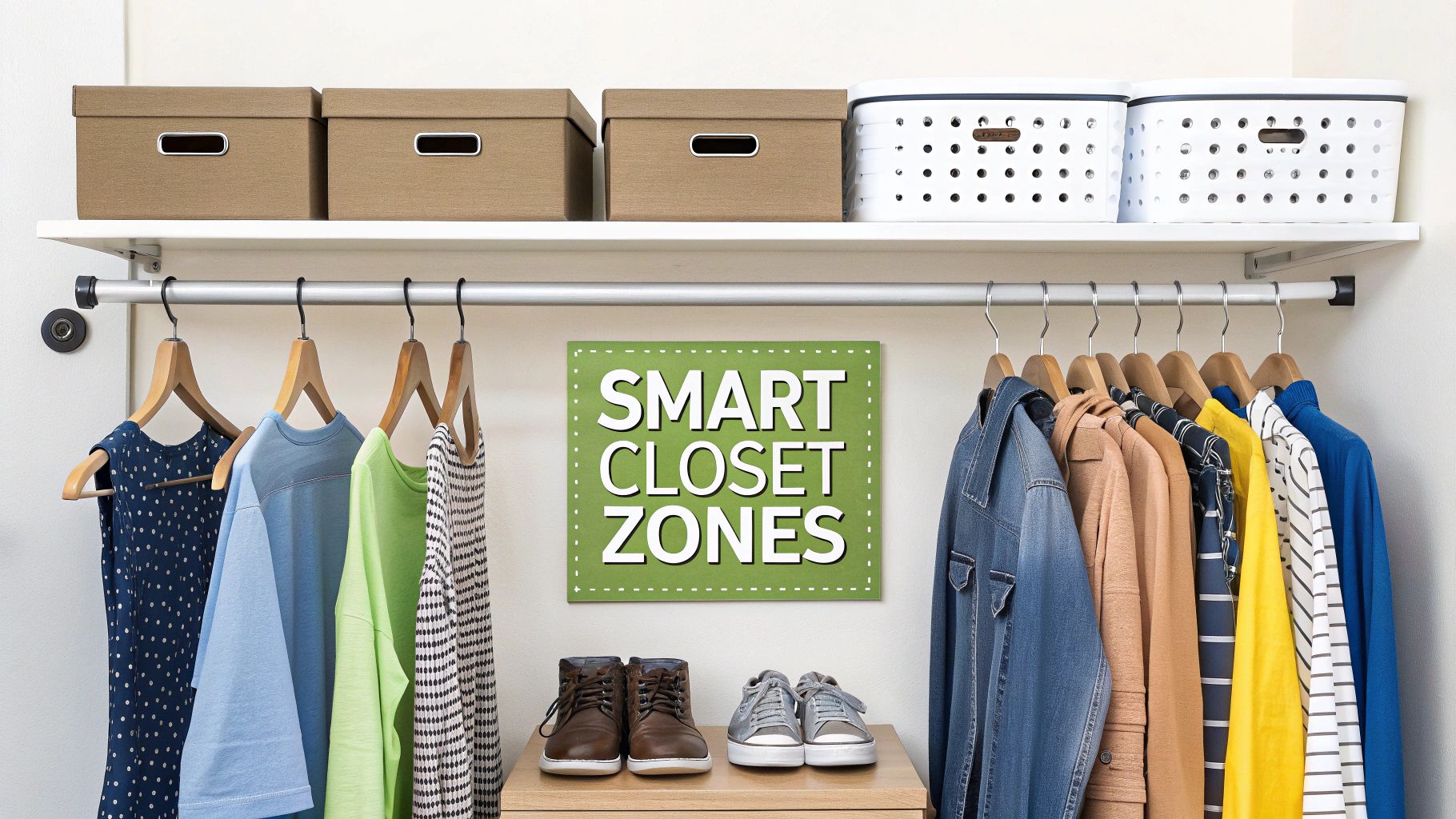Maximize Small Closet Space with Smart Organization

To truly conquer a small closet, you need to shift from simple tidying to strategic organization. This isn't about quick fixes; it's about building a lasting system through purposeful decluttering and smart storage solutions. The goal is a functional, stress-free closet that simplifies your daily routine and makes getting dressed easier.
From Overwhelmed to Organized: A New Closet Mindset

Staring into a cramped, chaotic closet is a frustrating way to start the day. That space is meant to simplify your life, not add stress. The real problem usually isn't just the lack of square footage; it's the lack of an organizational system. Without one, most small closets become a dumping ground.
That feeling of being overwhelmed is a huge roadblock. When clothes are spilling out and you can't find anything, the idea of organizing feels impossible. The trick is to reframe it. Stop seeing it as a chore and start seeing it as an opportunity to create a space that genuinely works for you and your lifestyle.
Preparing for a Strategic Overhaul
Before pulling a single shirt out, a little preparation makes all the difference. This isn’t just about cleaning—it's about setting yourself up for a successful organization project.
- Create a Clear Workspace: You’ll need a staging area. Your bed or a clear patch of floor works perfectly.
- Gather Your Supplies: Grab some boxes or bags and label them: Keep, Donate, Store, and Toss. This simple step is non-negotiable for efficient sorting.
- Schedule Uninterrupted Time: Block out a few hours on your calendar where you can focus. Rushing this process is how you end up with a half-finished mess.
Adopting the Four-Category Method
Now for the first step in organization: empty the entire closet. Yes, everything. This gives you a clean slate and helps you see the space for what it is. As you handle each item, sort it into one of your four prepped categories.
The goal of this initial purge isn't just to get rid of things. It's to make intentional decisions about what deserves to occupy your valuable closet real estate.
This methodical approach is your secret weapon against the dreaded "I'll deal with this later" pile. You have to be decisive here—it’s the foundation of your new, organized closet. It's a common goal, too. The drive for more functional living spaces is a huge trend, which has helped the custom closets market grow. In fact, around 55% of urban households worldwide are now opting for custom solutions. You can discover more insights about this trend and the custom closets market.
By shifting your mindset from a messy task to a strategic reset, you’re finally ready to take control and organize every inch of your small closet.
Making the Tough Calls: Curating Your Wardrobe
Now that you’re looking at an empty closet, the real organizational work begins. This is where you become intentional, deciding what truly earns its spot in your limited space. This step is what turns a chaotic closet into a curated, organized collection of pieces you actually love to wear.
As you pick up each item, be honest with yourself. Don't rush it. Hold up that shirt and ask some hard questions. Does this really fit me right now? Does this even feel like my style anymore? Thinking this way helps you detach from emotion and focus on practical organization.
A Framework for Deciding
To keep your sorting consistent, use a simple system. Think of it less as finding reasons to get rid of stuff and more as finding solid reasons to keep it. Every piece has to pass the test to get back into the closet.
- How does it fit and feel? Is it genuinely comfortable? Do you feel good in it? If something makes you feel self-conscious or is uncomfortable, it doesn't belong.
- What's the condition? Be a detective. Look for stains, rips, pilling, or faded color. If it's beyond saving or you know you’ll never get around to mending it, it's time to let go.
- The One-Year Rule: This one’s a classic for a good reason. Have you worn it in the last 12 months? If the answer is no, chances are you won't wear it in the next 12 either.
This kind of deliberate sorting is how you maximize small closet space, making sure every single hanger is holding something valuable.
What About Sentimental Pieces?
What about the items that fail all the tests but are attached to a powerful memory? This is where many organizational efforts get stuck. It’s a huge mistake to let these pieces take up prime real estate. You don't have to throw them away, but they can't live next to the clothes you wear every week.
Your active wardrobe and your memory archive are two totally different things. Treat them that way by storing sentimental items outside your main closet.
A dedicated memory box or a vacuum-sealed bag that can slide under the bed is the perfect solution. This way, you honor the memory without sacrificing the space you need for your daily life. It’s a guilt-free compromise that keeps your main closet organized.
The Capsule Wardrobe Idea
If you're ready to simplify in a big way, consider the capsule wardrobe concept. It's a fantastic organizational approach that involves building a small, curated collection of essential pieces that all work together.
A typical capsule wardrobe has about 30-40 items per season, including tops, bottoms, jackets, and shoes. The focus shifts from quantity to quality, from chasing trends to building a cohesive look. When you embrace this minimalist mindset, you don’t just save a ton of space. You also make getting dressed infinitely easier, finally killing that "closet full of clothes but nothing to wear" dilemma.
Choosing the Right Tools to Maximize Space
Once you’ve sorted your wardrobe, the real organizational magic begins. This is where you bring in the right tools to create a closet that works for you. Think of these organization products less as accessories and more as essential equipment for building a functional system. With tools designed for efficiency, you can finally work smarter with the space you have.
The demand for these solutions is huge. The global market for wardrobe organizers is expected to hit around $15 billion in 2025 and keeps growing as more people seek to make the most of smaller living spaces. You can read the full research on wardrobe storage trends to see how the industry is evolving.
The infographic below drives home why this matters. It shows just how much of our clothing we never even touch.

When you realize a huge chunk of your closet is taken up by unworn clothes, it becomes clear that organizing the items you actually love is a top priority.
Upgrading Your Hangers
If there’s one organizational change that will give you the most dramatic results, it's upgrading your hangers. Those clunky, mismatched plastic hangers you’ve collected are gobbling up precious rod space. Switching to a uniform set of space-saving hangers can instantly double—or even triple—your hanging room.
Not all hangers are created equal. Choosing the right type for your wardrobe needs is key to unlocking more space.
Space-Saving Hanger Comparison
| Hanger Type | Best For | Space-Saving Potential | Key Feature |
|---|---|---|---|
| Slim Velvet Hangers | Everyday tops, dresses, silky fabrics | High | Ultra-thin profile and a non-slip grip that keeps clothes in place. |
| Cascading Hangers | Outfit planning, coordinating sets, shirts | Very High | A single hanger hook holds multiple garments vertically, multiplying rod space. |
| S-Type Hangers | Pants, jeans, scarves, towels | High | Tiered bars store multiple items in one compact, easy-to-see spot. |
By strategically mixing these hanger types, you create a customized system that fits your clothes perfectly and makes the most of every inch.
And don’t forget about the hangers you’re not using! Keeping them organized prevents that tangled mess at the bottom of the closet. If you need some ideas, our guide on how to store hangers has you covered.
Leveraging Vertical Space
In a small closet, you must think vertically. The unused air between your shelf and the floor is prime real estate waiting to be claimed.
Don't just think horizontally along the rod and shelf. True space maximization comes from utilizing the full height of your closet, from floor to ceiling.
Hanging fabric shelves are a game-changer for bulky items like sweaters and jeans that tend to stretch out on hangers. They create instant cubbies without any drilling. Over-the-door organizers are another secret weapon; they’re perfect for stashing shoes, belts, or accessories, getting everything off the floor.
Finally, don’t underestimate the power of clear storage bins and shelf dividers. Being able to see what’s inside a bin means you won’t have to tear everything apart to find that one scarf. Shelf dividers are brilliant for keeping folded stacks of t-shirts or jeans from collapsing into a messy heap. When you choose tools that work together, you build an organizational system where everything has a clear, visible, and accessible home.
Making Sense of Your Space with Smart Zones

A genuinely organized closet isn't just about looking neat—it's about creating a system that works for you. This is where you graduate from simply storing clothes to building a strategic wardrobe that makes getting dressed easier. The secret is to give every item a logical home by creating distinct zones.
Start by grouping similar items together. All your tops go in one spot, your pants in another, your dresses somewhere else. This one change is a game-changer, ending the morning scramble for that one specific shirt. Think of it as the ground floor of an efficient closet organization system.
From there, you can get more granular. Take your tops and sort them further by sleeve length—tanks, short sleeves, long sleeves. Or separate them by occasion, like work blouses and weekend t-shirts. This fine-tuning is how you truly maximize small closet space, because it makes every decision feel automatic.
Claim Your Closet's Prime Real Estate
Not all closet space is created equal. The area at eye level, from about your waist to just above your head, is your prime real estate. It’s the easiest to see and access. This is where you should keep the clothes you wear most often. Your favorite jeans, go-to sweaters, and everyday shirts all belong here.
Anything you wear less often, like formal dresses or out-of-season coats, gets relegated to less convenient spots. The top shelf is perfect for storing bulky sweaters in labeled bins during the summer, and the floor can be used for shoes you don't wear daily or drawers holding specialty accessories.
Treat your most-worn clothes like VIPs and give them the best seats in the house. This shift in thinking can completely change how you get ready in the morning, saving time and frustration.
Build Zones Around Your Life
Once you’ve sorted your categories, take your organization a step further by creating zones based on your activities. This customizes your closet to fit your lifestyle, making it effortless to get ready for anything.
Here are a few zone ideas:
- Your "Work Week" Hub: Pull together five complete work outfits and give them their own dedicated section. This collection of go-to blouses, trousers, and blazers will make weekday mornings ridiculously smooth.
- The "Gym-Ready" Corner: Forget digging around for workout gear. Use a specific drawer, a shelf, or a hanging organizer to keep all your leggings, sports bras, and athletic tops in one place.
- An Accessory Station: Create a designated home for finishing touches. A few hooks on the wall are perfect for necklaces and belts, while small, clear trays on a shelf can keep sunglasses and watches organized.
This kind of system doesn't just make finding things easier; it makes putting them away a snap. When everything has a proper home, tidying up becomes a matter of seconds, not a major chore.
Keeping Your Organized Closet That Way for the Long Haul
You’ve put in the work, decluttered, and your closet looks fantastic. The real challenge? Maintaining that organization. A one-and-done clean-out feels great, but a system that prevents clutter from returning is life-changing. This is how you ensure your effort wasn't just a temporary fix.
One of the most powerful strategies is the seasonal swap. That bulky winter parka has no business hogging prime real estate in mid-summer. By rotating your wardrobe twice a year, you instantly free up a massive amount of space for the clothes you actually need right now.
The Art of the Seasonal Swap
Storing your off-season clothes correctly is about more than just getting them out of the way; it's about protecting them. A little prep work makes all the difference.
- Always Clean First: Before you pack anything away, make sure it's washed or dry-cleaned. Lingering body oils or food residue can attract pests and lead to permanent stains.
- Use Smart Storage: Flat, under-the-bed containers are perfect for keeping clothes protected and out of sight. For your puffiest coats and chunkiest sweaters, vacuum-sealed bags are your best friend—they shrink items to a fraction of their original size.
- Pick the Right Spot: Avoid the attic or basement if you can. Extreme temperatures and humidity can ruin fabrics. A much better choice is under your bed or on a high shelf in a spare closet.
This simple rotation is a cornerstone of how you can truly maximize small closet space all year long.
The point isn't just to hide clothes you aren't wearing. It's to create a living system where your closet reflects what you actually need, season by season.
Building Habits That Stick
A beautifully organized closet is the result of small, consistent actions. The key is to build simple routines. As more of us have moved into smaller city apartments, the need for smart organization has exploded. In places like the UK, pull-out drawers and modular systems are becoming standard. It's a global trend, and you can discover more insights about the closet organizers market to see how big it's getting.
To stop your closet from slowly refilling, make the 'one in, one out' rule your new mantra. It’s simple: every time you buy a new piece of clothing, an old one has to go. This habit maintains a perfect balance and stops clutter in its tracks.
Pair that with a quick 10-minute weekly tidy-up. Take a few minutes to re-fold anything that's gotten messy or hang up clothes that ended up on "the chair." When you do your big seasonal swap, use that as your time for a deeper decluttering session. These little routines are what separate a temporary fix from a permanently peaceful, organized space.
Frequently Asked Closet Organization Questions
Even the most organized person can get stumped by a tiny closet. After helping countless people tackle their wardrobes, I've noticed the same few questions always come up. If you're struggling with these common organizational roadblocks, you're not alone.
How Can I Organize Shoes Without Using All My Floor Space?
Shoes are chaos-magnets in a small closet. The second they hit the floor, your space feels cluttered. The key is to get them off the ground by thinking vertically.
- Go Over the Door: An over-the-door shoe organizer is a game-changer. It uses dead space, keeps every pair visible, and frees up precious floor space.
- Stack Them High: Clear, stackable shoe boxes are a brilliant solution. They protect your shoes from dust and crushing, and you can see exactly what's inside. Build a tower on a high shelf to use every vertical inch.
- Hang Your Boots: Don't let tall boots slump on the floor. Boot hangers clip onto your closet rod, keeping boots upright, uncreased, and out of the way, reclaiming significant floor space.
What Is the Best Way to Store Bulky Sweaters and Jeans?
I see this mistake all the time: people hanging their heavy sweaters. This leads to stretched-out necklines and misshapen shoulders. For bulky items like knits and denim, folding is your best organizational tool.
A word of warning: never, ever hang your heavy knit sweaters. It will permanently ruin their shape. Folding is the only way to go to keep them looking great for years.
For sweaters, fold them neatly and use shelf dividers to keep your stacks from tipping over. For jeans, you have a couple of solid options. You can use S-type hangers to hang several pairs in the space of one, or "file-fold" them into neat rectangles and line them up in a drawer or bin like files in a cabinet, making every pair easy to see and grab.
My Closet Has No Built-In Features. Where Do I Start?
An empty-box closet can feel overwhelming, but I see it as a blank canvas—an opportunity to create a system perfectly tailored to your wardrobe. Modular solutions are your best bet.
A simple tension rod is the fastest way to instantly double your hanging space—just pop it in below your main rod, no tools needed. Then, bring in a small freestanding cube organizer or a small dresser to sit on the floor. This immediately gives you shelving and drawer space.
Finally, don't underestimate fabric hanging organizers. The kind that loop right over the closet rod are perfect for creating instant shelves for T-shirts, bags, or accessories. With just these few additions, you can transform that empty space into a fully functional, organized closet.
Ready to reclaim your closet? The right tools make all the difference. Explore MORALVE’s collection of space-saving hangers and organization solutions to build a smarter, more efficient wardrobe today. Start organizing at https://moralve.com.


Leave a comment